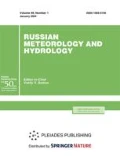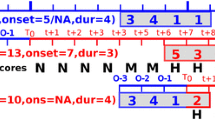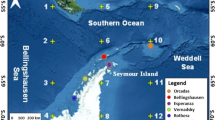Abstract
The Extreme Forecast Index (EFI) calculations are performed using the ECMWF 2-m air temperature forecasts produced in the framework of the Subseasonal to Seasonal (S2S) Prediction Project. Four computation schemes are implemented using empirical and theoretical distributions of heat wave characteristics as well as the one-dimensional test statistics of histograms and linear interpolation formulas. Case studies (for different initial dates and regions) characterized by the significant air temperature anomalies in Northern Eurasia are performed using traditional forecast skill scores and the spatial verification methods to evaluate the efficiency of the proposed schemes for different threshold values of EFI. It is shown that the forecast quality can be considered satisfactory in most cases. The dependence of forecast skill on the intensity, spatial scales, and duration of temperature anomalies is revealed. Further studies should be carried out using larger samples based on several hydrodynamic models and the multimodel approach.
Similar content being viewed by others
References
R. B. Zaripov, Yu. B. Pavlyukov, A. A. Shumilin, and A. V. Travov, “Application of Radar Information for Verification of the High-resolution Numerical Weather Prediction,” Gidrometeorologicheskie Issledovaniya i Prognozy, No. 2 (2018) [in Russian].
D. B. Kiktev, “On the Use of the Extreme Forecast Index for Long-range Weather Forecasting,” Problemy Ekologicheskogo Monitoringa i Modelirovaniya Ekosistem, 24 (2011) [in Russian].
D. B. Kiktev, M. A. Tolstykh, and V. M. Mirvis, “On Predictability of Extreme Weather Events on Subseasonal Timescales,” in Extreme Floods in the Amur River Basin: Causes, Forecasts, and Recommendations (Roshydromet, Moscow, 2014) [in Russian].
E. N. Kruglova, I. A. Kulikova, V. A. Tishchenko, and V. M. Khan, “Forecasting of Heat Waves on Subseasonal Timescales,” Gidrometeorologicheskie Issledovaniya i Prognozy, No. 1 (2019) [in Russian].
A. V. Murav’ev, D. B. Kiktev, and A. V. Smirnov, “Operational Precipitation Nowcasting System Based on Radar Data and Verification Re sults for the Warm Period of the Year (May-September 2017),” Gidrometeorologicheskie Issledovaniya i Prognozy, No. 1 (2018) [in Russian].
Guide to Hydrological Practices, Vol. 1: Hydrology—From Measurement to Hydrological Information, WMO-No. 168 (WMO, 2011) [Transl. from English].
GD 52.27.724-2009 “Manual on General-purpose Short-range Weather Forecasting” (Federal Service for Hydrometeorology and Environmental Monitoring, Moscow, 2009) [in Russian].
A. G. Barnston and R. E. Livezey, “Classification, Seasonality, and Persistence of Low-frequency Atmospheric Circulation Patterns,” Mon. Wea. Rev., 115 (1987).
A. G. Barnston and S. J. Mason, “Evaluation of IRI’s Seasonal Climate Forecasts for the Extreme 15% Tails,” Wea. Forecast., 26 (2011).
Disaster Risk Reduction Roadmap for the World Meteorological Organization, Final Draft (Version 2.1), March 31, 2017.
E. Dutra, M. Diamantaki, I. Tsonevsky, E. Zsoter, F. Wetterhall, T. Stockdale, D. Richardson, and F. Pappenberger, The Extreme Forecast Index Applied to Seasonal Forecasts, ECMWF Technical Memoranda, No. 703 (2013).
E. E. Ebert, “Neighborhood Verification: A Strategy for Rewarding Close Forecasts,” Wea. Forecast., 24 (2009).
Forecast Verification in Atmospheric Science. A Practitioner’s Guide, 2nd ed., Ed. by I. Jolliffe and D. Stephenson (John Wiley & Sons Ltd, 2012).
E. Gilleland, D. A. Ahijevych, B. G. Brown, B. Casati, and E. E. Ebert, “Intercomparison of Spatial Forecast Verification Methods,” Wea. Forecast., 24 (2009).
E. Gilleland, D. A. Ahijevych, B. G. Brown, and E. E. Ebert, “Verifying Forecasts Spatially,” Bull. Amer. Meteorol. Soc., 91 (2010).
E. Hamilton, R. Eade, R. J. Graham, D. M. Smith, A. A. Scaife, A. Maidens, and C. MacLachlan, “Forecasting the Number of Extreme Daily Events on Seasonal Timescales,” J. Geophys. Res., 117 (2012).
T. Hewson, Severe Weather Prediction at ECMWF: Recent Developments and Future Challenges (2014), https://www.wmo.int/pages/prog/arep/wwrp/new/wwosc/documents/WWOSC2014_Hewson_SevereWeaterECMWF.pdf.
J. R. M. Hosking, “L-moments: Analysis and Estimation of Distributions Using Linear Combinations of Order Statistics,” J. Roy. Statist. Soc., No. 1, 52 (1990).
D. Hudson, A. G. Marshall, O. Alves, G. Young, D. Jones, and A. Watkins, “Forewarned is Forearmed: Extended-range Forecast Guidance of Recent Extreme Heat Events in Australia,” Wea. Forecast., No. 3, 31 (2016).
F. Lalaurette, “Early Detection of Abnormal Weather Conditions Using a Probabilistic Extreme Forecast Index,” Quart. J. Roy. Meteorol. Soc., No. 594, 129 (2003).
A. H. Murphy, “The Finley Affair: A Signal Event in the History of Forecast Verification,” Wea. Forecast., 11 (1996).
A. S. Pepler, L. B. Diaz, C. Prodhomme, F.-J. Doblas-Reyes, and A. Kumar, “The Ability of a Multi-model Seasonal Forecasting Ensemble to Forecast the Frequency of Warm, Cold and Wet Extremes,” Wea. Climate Extremes, 9 (2015).
J. Pickands, “Statistical Interference Using Extreme Order Statistics,” Ann. Statistics, No. 1, 3 (1975).
F. Porter, Testing Consistency of Two Histograms, https://www.researchgate.net/publication/1917663_Testing_Consistency_of_Two_Histograms.
N. M. Roberts and H. W. Lean, “Scale-selective Verification of Rainfall Accumulations from High-resolution Forecasts of Convective Events,” Mon. Wea. Rev., 136 (2008).
D. M. Sills, “On the MSC Forecasters Forum and the Future Role of the Human Forecaster,” Bull. Amer. Meteorol. Soc., No. 5, 90 (2009).
Strategic Plan for the Implementation of the WMO’s World Weather Research Programme (WWRP): 2009–2017, WMO/TD-No. 1505 (Geneva, Switzerland, 2009).
D. S. Wilks, Statistical Methods in the Atmospheric Sciences, 3rd ed. (Academic Press, London, 2011).
E. Zsoter, “Recent Developments in Extreme Weather Forecasting,” ECMWF Newsletter, No. 107 (2006).
Acknowledgments
The authors thank the Doctor of Physics and Mathematics A.V. Murav’ev for assistance.
Author information
Authors and Affiliations
Corresponding author
Additional information
Russian Text © The Author(s), 2020, published in Meteorologiya i Gidrologiya, 2020, No. 1, pp. 5–22.
About this article
Cite this article
Kiktev, D.B., Kruglova, E.N. & Kulikova, I.A. On the Evaluation of the Extremality Index EFI. Russ. Meteorol. Hydrol. 45, 1–12 (2020). https://doi.org/10.3103/S106837392001001X
Received:
Revised:
Accepted:
Published:
Issue Date:
DOI: https://doi.org/10.3103/S106837392001001X




